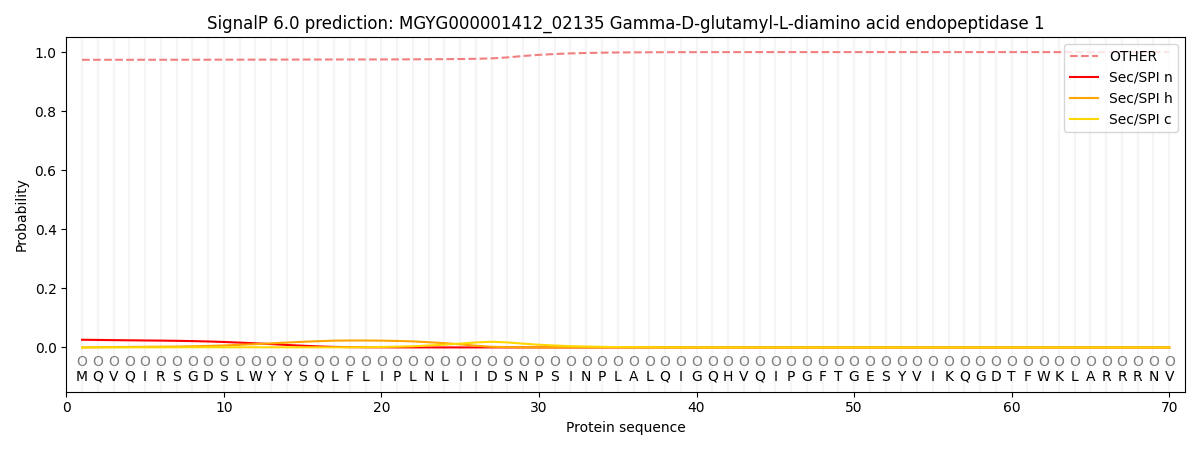You are browsing environment: HUMAN GUT
CAZyme Information: MGYG000001412_02135
You are here: Home > Sequence: MGYG000001412_02135
Basic Information |
Genomic context |
Full Sequence |
Enzyme annotations |
CAZy signature domains |
CDD domains |
CAZyme hits |
PDB hits |
Swiss-Prot hits |
SignalP and Lipop annotations |
TMHMM annotations
Basic Information help
| Species | Robertmurraya massiliosenegalensis | |||||||||||
|---|---|---|---|---|---|---|---|---|---|---|---|---|
| Lineage | Bacteria; Firmicutes; Bacilli; Bacillales_B; DSM-18226; Robertmurraya; Robertmurraya massiliosenegalensis | |||||||||||
| CAZyme ID | MGYG000001412_02135 | |||||||||||
| CAZy Family | CBM50 | |||||||||||
| CAZyme Description | Gamma-D-glutamyl-L-diamino acid endopeptidase 1 | |||||||||||
| CAZyme Property |
|
|||||||||||
| Genome Property |
|
|||||||||||
| Gene Location | Start: 226062; End: 227249 Strand: - | |||||||||||
CDD Domains download full data without filtering help
| Cdd ID | Domain | E-Value | qStart | qEnd | sStart | sEnd | Domain Description |
|---|---|---|---|---|---|---|---|
| cd06229 | M14_Endopeptidase_I | 4.88e-114 | 155 | 389 | 1 | 238 | Peptidase M14 carboxypeptidase family-like domain of Endopeptidase I. Peptidase M14-like domain of Gamma-D-glutamyl-L-diamino acid endopeptidase 1 (also known as Gamma-D-glutamyl-meso-diaminopimelate peptidase I, and Endopeptidase I (ENP1); EC 3.4.19.11). ENP1 is a member of the M14 family of metallocarboxypeptidases (MCPs), and is classified as belonging to subfamily C. However it has an exceptional type of activity of hydrolyzing the gamma-D-Glu-(L)meso-diaminopimelic acid (gamma-D-Glu-Dap) bond of L-Ala-gamma-D-Glu-(L)meso-diaminopimelic acid and L-Ala-gamma-D-Glu-(L)meso-diaminopimelic acid(L)-D-Ala peptides. ENP1 has a different substrate specificity and cellular role than MpaA (MpaA does not belong to this group). ENP1 hydrolyzes the gamma-D-Glu-Dap bond of MurNAc-tripeptide and MurNAc-tetrapeptide, as well as the amide bond of free tripeptide and tetrapeptide. ENP1 is active on spore cortex peptidoglycan, and is produced at stage IV of sporulation in forespore and spore integuments. |
| smart00631 | Zn_pept | 5.06e-44 | 110 | 382 | 2 | 277 | Zn_pept domain. |
| cd00596 | Peptidase_M14_like | 1.02e-35 | 155 | 384 | 1 | 211 | M14 family of metallocarboxypeptidases and related proteins. The M14 family of metallocarboxypeptidases (MCPs), also known as funnelins, are zinc-binding carboxypeptidases (CPs) which hydrolyze single, C-terminal amino acids from polypeptide chains, and have a recognition site for the free C-terminal carboxyl group, which is a key determinant of specificity. Two major subfamilies of the M14 family, defined based on sequence and structural homology, are the A/B and N/E subfamilies. Enzymes belonging to the A/B subfamily are normally synthesized as inactive precursors containing preceding signal peptide, followed by an N-terminal pro-region linked to the enzyme; these proenzymes are called procarboxypeptidases. The A/B enzymes can be further divided based on their substrate specificity; Carboxypeptidase A-like (CPA-like) enzymes favor hydrophobic residues while carboxypeptidase B-like (CPB-like) enzymes only cleave the basic residues lysine or arginine. The A forms have slightly different specificities, with Carboxypeptidase A1 (CPA1) preferring aliphatic and small aromatic residues, and CPA2 preferring the bulky aromatic side chains. Enzymes belonging to the N/E subfamily enzymes are not produced as inactive precursors and instead rely on their substrate specificity and subcellular compartmentalization to prevent inappropriate cleavage. They contain an extra C-terminal transthyretin-like domain, thought to be involved in folding or formation of oligomers. MCPs can also be classified based on their involvement in specific physiological processes; the pancreatic MCPs participate only in alimentary digestion and include carboxypeptidase A and B (A/B subfamily), while others, namely regulatory MCPs or the N/E subfamily, are involved in more selective reactions, mainly in non-digestive tissues and fluids, acting on blood coagulation/fibrinolysis, inflammation and local anaphylaxis, pro-hormone and neuropeptide processing, cellular response and others. Another MCP subfamily, is that of succinylglutamate desuccinylase /aspartoacylase, which hydrolyzes N-acetyl-L-aspartate (NAA), and deficiency in which is the established cause of Canavan disease. Another subfamily (referred to as subfamily C) includes an exceptional type of activity in the MCP family, that of dipeptidyl-peptidase activity of gamma-glutamyl-(L)-meso-diaminopimelate peptidase I which is involved in bacterial cell wall metabolism. |
| pfam00246 | Peptidase_M14 | 1.05e-23 | 119 | 384 | 5 | 283 | Zinc carboxypeptidase. |
| COG2866 | MpaA | 1.38e-21 | 131 | 384 | 123 | 370 | Murein tripeptide amidase MpaA [Cell wall/membrane/envelope biogenesis]. |
CAZyme Hits help
| Hit ID | E-Value | Query Start | Query End | Hit Start | Hit End |
|---|---|---|---|---|---|
| QOK25068.1 | 1.33e-197 | 1 | 395 | 1 | 395 |
| AND41500.1 | 7.62e-190 | 1 | 395 | 1 | 395 |
| QVY60335.1 | 2.39e-186 | 1 | 395 | 1 | 395 |
| UAC47242.1 | 1.38e-185 | 1 | 395 | 1 | 395 |
| AIE60727.1 | 3.73e-183 | 1 | 395 | 1 | 395 |
Swiss-Prot Hits download full data without filtering help
| Hit ID | E-Value | Query Start | Query End | Hit Start | Hit End | Description |
|---|---|---|---|---|---|---|
| Q03415 | 3.77e-143 | 1 | 395 | 1 | 396 | Gamma-D-glutamyl-L-diamino acid endopeptidase 1 OS=Lysinibacillus sphaericus OX=1421 PE=1 SV=1 |
| P54497 | 4.97e-97 | 110 | 394 | 84 | 373 | Uncharacterized protein YqgT OS=Bacillus subtilis (strain 168) OX=224308 GN=yqgT PE=3 SV=1 |
| Q9XU75 | 7.84e-11 | 126 | 320 | 178 | 375 | Putative carboxypeptidase suro-1 OS=Caenorhabditis elegans OX=6239 GN=suro-1 PE=1 SV=2 |
| E5A0U8 | 1.14e-07 | 134 | 329 | 243 | 439 | Inactive metallocarboxypeptidase ECM14 OS=Leptosphaeria maculans (strain JN3 / isolate v23.1.3 / race Av1-4-5-6-7-8) OX=985895 GN=ECM14 PE=3 SV=1 |
| O17754 | 2.26e-06 | 134 | 256 | 66 | 179 | Carboxypeptidase E OS=Caenorhabditis elegans OX=6239 GN=egl-21 PE=1 SV=1 |
SignalP and Lipop Annotations help
This protein is predicted as OTHER

| Other | SP_Sec_SPI | LIPO_Sec_SPII | TAT_Tat_SPI | TATLIP_Sec_SPII | PILIN_Sec_SPIII |
|---|---|---|---|---|---|
| 0.976279 | 0.023512 | 0.000110 | 0.000049 | 0.000023 | 0.000048 |
